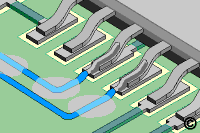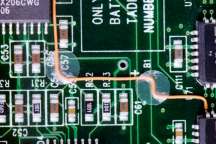Ten Rules for Jumper Wires
|
The twists and turns of working with jumper wires.
The need to attach jumper wires to circuit board assemblies is inevitable. Essentially, jumper wires fall into three basic categories:
- Those that are considered a component and part of the original design. The routing, termination, and bonding of these jumper wires should be documented by engineering instructions or drawing notations.
- Those that are added after the original design and fabrication to effect a modification. The routing, termination, and bonding of these jumper wires should be documented by engineering change notice instructions or drawing notations; and
- Those that are added to correct a defect.

|
|
|
Figure 1: Jumper wires can be attached in a variety of ways.
|
The procedures for attaching jumper wires, all told, are fairly extensive and would require more space than available in this feature. However, there are a number of general rules that should be followed when attaching and working with jumper wires. Here are the rules and the reasons for them:
- Jumper wires should be placed on the component side of the circuit board assembly when possible. Of course, many circuit board designs have components on both sides, but, since jumper wires are considered components, they should be placed on the side of the circuit board with the majority of large components.
- Jumper wires should be routed in an X-Y manner as directly as feasible, making as few bends as possible. Direct routing aids organization, saves material, etc. - simpler and shorter enhances reliability.
- Jumper wires should not be raised more than 3.2 mm (.125") inch above the board surface or not above components or leads in such a way that they will interfere with circuit board mounting. The obvious reason for this rule is to minimize the potential for them to get caught or damaged.
- Bare conductor jumper wires longer than 12.7 mm (0.50") should not be used. Bare conductor jumper wires shorter than 12.7 mm (0.50") should not violate the minimum electrical clearance (the 12.7 mm (0.50") dimension refers to the length between terminations).
-

|
|
|
Figure 2: Jumper wires should be bonded or taped to the circuit board surface.
|
Jumper wires should not pass over unused component lands or pads unless the assembly layout prohibits routing in other areas. If a jumper wire passes over an unused land or pad, sufficient slack should be provided so that the jumper wire can be moved out of the way should a component need to be added. Jumper wires should not pass over pads or vias used as test points. Once jumper wires have been added to a circuit board, the less they are disturbed or moved, the better.
- Jumper wires shall not be routed under or over component leads or component bodies. Contact with heat sinks must be avoided. The reason is simple; components may need to be reworked, and they cannot be reworked effectively if access is blocked by jumper wires. Heat sinks may melt wire insulation and result in shorts.
- Jumper wires should include stress relief. Thermal expansion and mechanical stress affect all components, including jumper wires. Adding a bit of slack near the termination point is all that is needed. As an added note, you should avoid very tight bends in jumper wires. Avoid bending the jumper wire tighter than a radius of 3 times the conductor diameter.
- If you have no alternative and must run a jumper wire from one side of the circuit board to the other, it may be routed through a plated through-hole, provided the wire is insulated, and insulation sleeving is placed in the hole. You can also drill a hole through the circuit board to route a wire from one side. Of course, you must take great care to avoid interfering with surface and internal conductors.
- Jumper wires soldered into plated through holes must be discernible on the opposite side. Just like a through-hole component lead, you should be able to see the outline of the wire in the solder connection.
- Jumper wires soldered to lifted, or clipped component leads should be insulated to prevent shorting.
Jumper wires may be terminated by a variety of methods. To learn more, see the detailed procedure on Jumper Wires.
Several members of the Circuit Technology Center team contributed to this feature story.
|
|
|
|
|